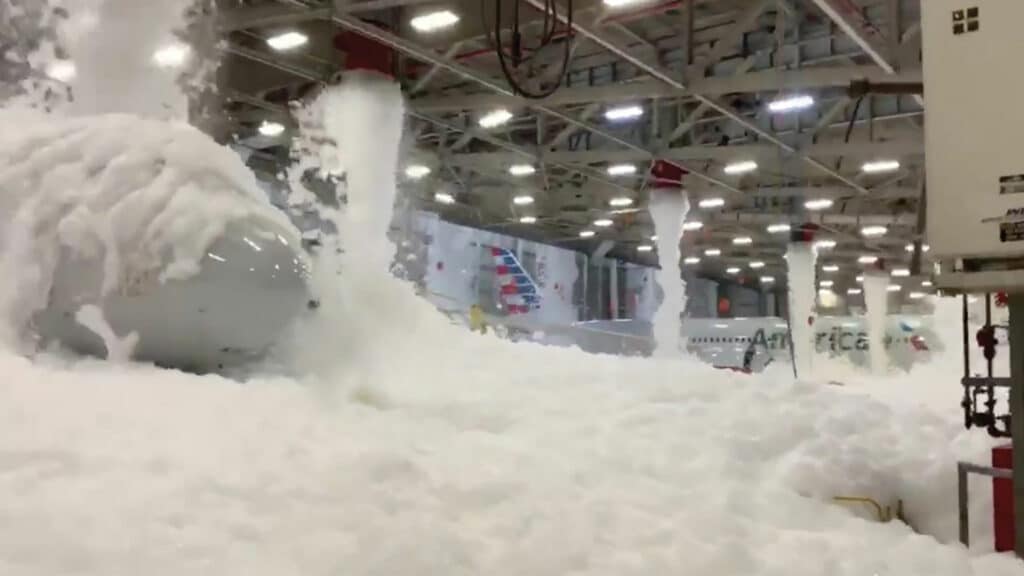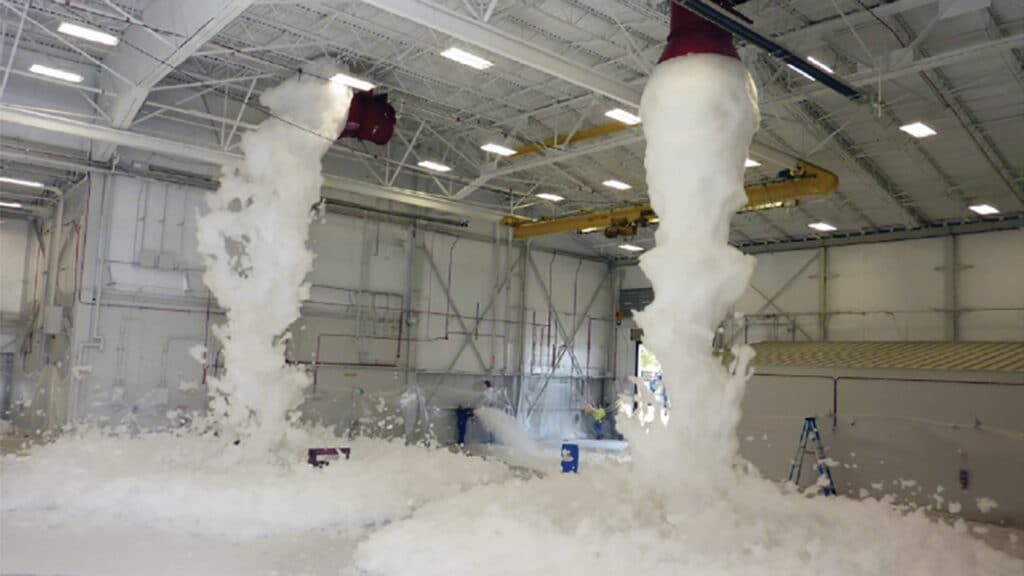Recent Developments: Hangar Fire Protection
Inadvertent discharge of foam fire suppression systems in aircraft hangars continues to occur regularly throughout the world since we wrote our white paper outlining issues surrounding accidental discharges in April 2019. These events plague aviation and remain top of mind for many industry participants.

The central question is still pertinent:
Do we need sophisticated foam fire suppression systems in certain hangar environments given the accidental discharge risks, high installation/maintenance costs and technological advancements in the industry that have reduced the risk of fires? It’s an especially compelling question since there are hardly any actual fuel spill fires seen in the data. In other words, are the industry-standard fire protection criteria still appropriate for the hazards and risks in today’s aviation ecosystem?
The ongoing debate within the industry about the necessity of these systems has grown even louder in light of recent events. A number of accidental discharges have occurred or were reported in the 18 months since we published our white paper:
- A foam discharge event in a large hangar in Europe involving several VIP airliner aircraft caused tens of millions of dollars in aircraft damage.
- An FBO in the Midwestern U.S. had 15 aircraft in a hangar in which a pinhole in a fire system tank caused a discharge resulting in $2 million USD in damage.
- An Airbus hangar in the Southern U.S. had two A220s under construction and the extent of the damage
is unknown. - A prominent FBO in Florida experienced a foam discharge involving a Gulfstream G650 and Bombardier Global Express among several aircraft being submerged in foam.
- Following a discharge event (March 2020) in a Delta Airlines hangar at Los Angeles International Airport, photos showed multiple aircraft engulfed in massive amounts of foam—so much that it flowed out onto the ramp.
It’s important to note that no fires were reported in any of the above incidents.
Foam fire suppression systems are designed to combat pooled-fuel fires in hangars. These systems are mandatory for most modern hangars. The standards around fire protection are set forth by the National Fire Protection Association (NFPA) and frequently adopted into state and local building codes.
Many industry stakeholders including hangar owners and operators, trade associations, aircraft owners, FBOs and insurers continue to ask: Is anything going to change?
Are Voices Being Heard?
The National Air Transportation Association (NATA) has been hard at work advocating for change on behalf of its members. NATA has developed various resources to help with understanding the issues around foam fire suppression systems, handling a discharge event and dealing with your local fire marshal.
NATA also commissioned a study to review foam discharges in hangars. This was carried out by the University of Maryland (with Global Aerospace providing some claims data to support the study) and the findings showed that frequent accidental discharges occur at a much higher rate compared to intentional discharges in response to an actual fire. The study added gravity and credibility to industry stakeholders’ calls for change.
In our white paper, we referenced an NATA initiative to adopt changes to NFPA 409—the fire protection standards applicable to aircraft hangars. Some of the changes being proposed—requiring foam fire suppression only for Group II hangars with hazardous operations, raising door height thresholds to accommodate larger and newer business jets and reinstating the cluster hangar exemption—would have the effect of significantly reducing the burden of fire suppression systems now borne by many general aviation participants.

Will Feedback Yield Change?
In 2019, the NFPA solicited industry feedback and received hundreds of comments from stakeholders, in addition to the aforementioned NATA member feedback. In summer 2020, the Fire Protection Research Foundation (the research arm for the NFPA) commissioned an RFP to assess the “performance criteria for aircraft hangar fire protection systems.” This could represent a tacit acknowledgment that current systems may not be optimised.
Meanwhile, another emerging issue around foam fire suppression systems is the foam itself and the toxic environmental impact from certain foam chemicals. California has proposed legislation to ban PFAS (certain chemical substances found in fire suppression foam) and several other states are not far behind.
So, a continuation of accidental discharges, a growing chorus of feedback from industry and newfound concerns around environmental impacts together could serve as catalysts for the NFPA 409 Technical Committee (TC) to adopt some changes to the fire protection standards.
A Postponed Meeting and Important Best Practices
The NFPA 409 TC had planned meetings with its members in 2020 to discuss some of the industry feedback, but unfortunately, these meetings have been postponed until 2021 because of the COVID-19 crisis. Stay tuned. In the meantime, we encourage stakeholders to adopt best practices for hangar and aircraft safety. Some examples to help with risk management and preparedness include:
- Secure aircraft by closing doors when unattended
- Cover engine intakes
- Follow prescribed maintenance protocols
- Develop emergency response protocols for an accidental discharge scenario
Additionally, we recommend speaking with your local fire marshal. Anecdotal evidence suggests that certain fire marshals are moving faster than the hangar fire protection standards revision process and independently question the efficacy of the advanced fire suppression systems in low-threat environments. A large U.S. metropolitan city fire department recently waived foam fire suppression requirements for a Group II hangar construction project.
While we continue to see unwelcome accidental discharges resulting in significant aircraft and other property damage, as well as business interruption costs and expenses, we have been fortunate to avoid any bodily injury arising from recent events. However, this continues to be a major source of concern.
Advocates for Amended Standards
Whether NFPA makes changes to the 409 standard remains to be seen. It is clear that the industry has spoken and appears to have caught the attention of the NFPA 409 TC.
For our part, Global Aerospace continues to believe the standards should be amended to reflect reduced fire risks thanks to technological advances in aircraft manufacturing and fuel chemistry as well as generally improved operational protocols in aviation.




